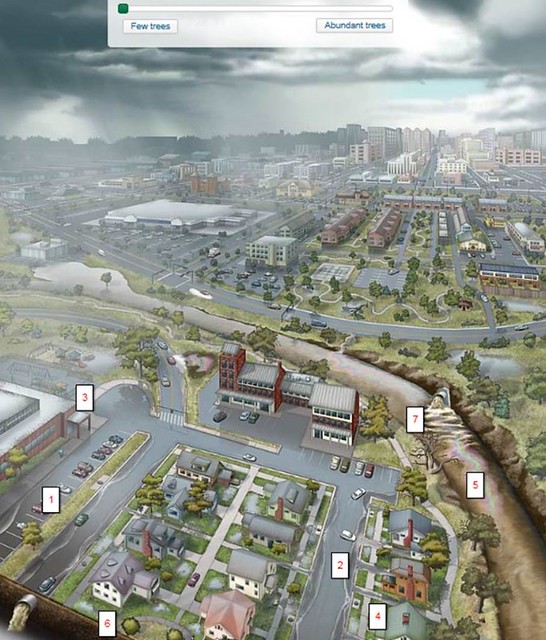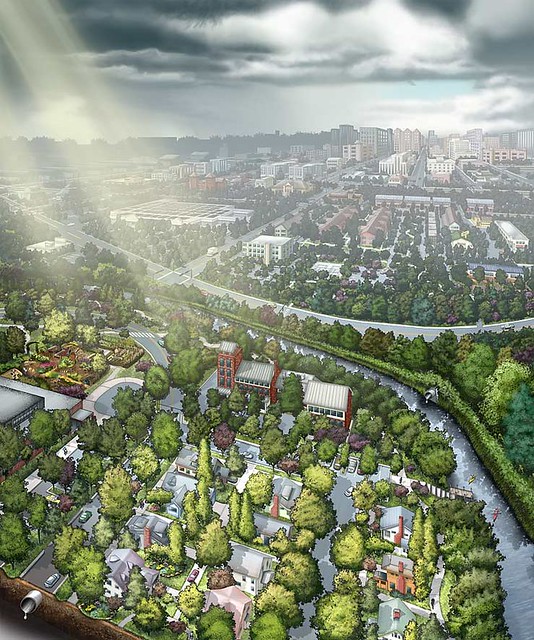A Placemaking Journal
Green in the City: A recipe for mental and environmental health
 The National Arbor Day Foundation has a simple app on its website that allows visitors to see how a city changes as it adds tree cover and other vegetation. Using a little sliding tool, one can gradually change the illustration from one with few trees to one with abundant trees. The difference is striking: everyone I know would prefer to live in the greener city.
The National Arbor Day Foundation has a simple app on its website that allows visitors to see how a city changes as it adds tree cover and other vegetation. Using a little sliding tool, one can gradually change the illustration from one with few trees to one with abundant trees. The difference is striking: everyone I know would prefer to live in the greener city.
I love the Arbor Day app, but this is not a new subject for me. I have long maintained that the fates of nature and cities are intricately related: Nature needs cities, a truth still not sufficiently appreciated in the world of environmental advocacy, because compact urban and suburban communities reduce development pressure on the natural and rural landscape.
We can’t save the landscape with sprawl. But, just as important, cities need nature, a truth not sufficiently appreciated in the world of urbanist advocacy. Cities need both the beauty and function of nature, to reduce runoff pollution, restore and improve human and ecosystem health and, frankly, to make urban living more beautiful and pleasant, among other things.
One of the drivers of sprawl in the last several decades has been the perception that one has needed to move away from cities to get closer to nature. There are a lot of problems and sometimes disillusionment with the way that perception works out in practice, especially since sprawl begets more sprawl, eating up the very nature that once attracted people out there. But there remains a grain of truth in the proposition, as we have allowed many of our cities to become nature-deprived.
Why should it be that way? Why can’t we have the benefits of walkable neighborhoods and compact regions, along with the benefits of nature in cities?
We can. And, when we do, both humans and the ecosystem benefit. There’s a growing body of science to support both propositions, which I explore in some depth here. I’ll be briefer in this article, and address the pollution-reducing benefits first, since that’s what the Arbor Day Foundation emphasizes in conjunction with their illustrations.

Rain refreshes the land and nourishes the green landscape. But as houses, stores, schools, roads and parking lots spread and natural tree cover is lost, so is the absorbing effect of vegetation and soil. The welcome rain becomes costly stormwater runoff. Without the benefit of trees and vegetated infrastructure, waterways are polluted as oils, heavy metal particles and other harmful substances are washed away. Fish and wildlife suffer, drinking water becomes expensive or impossible to reclaim, property values are reduced, and our living environment is degraded.
You can click on various numbered spots in the app to learn how trees and vegetation address the problems.
There’s a bit of a paradox here with the interaction of cities and runoff pollution, since compact regions help keep pavement out of well-functioning rural watersheds. Urban density can reduce runoff at the whole-watershed scale compared to suburban sprawl with its accompanying spread-out roads and parking lots.
But, however good urban density can be when measured at the whole-watershed scale, unless cities sufficiently integrate absorbent vegetation and related green infrastructure into the urban fabric, the impermeable pavement and rooftops associated with dense cities can cause local runoff pollution to be severe. The federal EPA estimates that more than 10 trillion gallons of untreated urban and suburban stormwater runoff makes its way into our surface waters each year, degrading recreation, destroying fish habitat, and altering stream ecology and hydrology. In the case of older cities whose sewer systems collect both stormwater and domestic and industrial sewage in the same pipes, the result during heavy rain events can be combined sewer overflows, something no one wants in her neighborhood.
As the Arbor Day Foundation correctly points out, trees are part of the solution. So are parks, community gardens, bioswales, rain gardens, green roofs, roadside plantings, permeable paving, rainwater harvesting and other green infrastructure measures. In addition to their stormwater benefits, these measures reduce summertime heat and consequent demand for energy; they absorb carbon dioxide, too.

I won’t repeat what I’ve written elsewhere with regard to the efficacy of urban nature, but this week I ran across yet another study, this one from the University of Exeter Medical School in the United Kingdom. Using data from over 1,000 participants, the research team focused on two groups of people: those who moved to greener urban areas, and those who relocated to less green urban areas.
In findings released last year, the researchers found that, on average, movers to greener areas experienced an immediate improvement in mental health that was sustained for at least 3 years after they moved. (The study also showed that people relocating to a less green area suffered a drop in mental health, though in their case the drop was not sustained.)
The authors adjusted their data to remove effects from other factors likely to affect mental health over time – such as income, employment and education – as well as factors related to personality. Lead researcher Ian Alcock believes the study’s results could have important implications:
“We’ve shown that individuals who move to greener areas have significant and long-lasting improvements in mental health. These findings are important for urban planners thinking about introducing new green spaces to our towns and cities, suggesting they could provide long term and sustained benefits for local communities.”
The data in the study came from the British Household Panel Survey, a repository of information gathered from questionnaires filled in by households across Great Britain.
For more information from the National Arbor Day Foundation on the benefits of trees, go here.
Originally featured on the Huffington Post. Reprinted here with Kaid’s permission. Move your cursor over the images for credit information.
If PlaceShakers is our soapbox, our Facebook page is where we step down, grab a drink and enjoy a little conversation. Looking for a heads-up on the latest community-building news and perspective from around the web? Click through and “Like” us and we’ll keep you in the loop.




